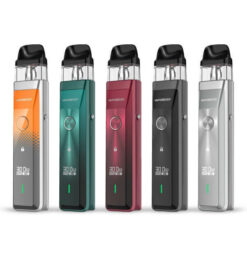The History of Vapes
With vaping gaining huge popularity in the past few years, you might be wondering “how long have vapes been around?” Well, vaping has actually been around for decades. In fact, the first patented vape was in 1930 by a man called Joseph Robinson, who came up with the design and filed it in 1927.
Despite this, his e-cigarette concept was never commercialised, nor was a prototype discovered to have been built by him.
Now in today’s society, you can pretty much go into any corner shop and see a display of disposable vapes and a beer garden full of vapour clouds. Not only are vapes an effective quit smoking aid, but Public Health England has said in research and studies that vaping is 95% less dangerous than smoking.

When Were Vapes Invented?
Following Joseph Robinson’s attempt to introduce e-cigarettes to the world in the 1920s, American Herbert A. Gilbert is credited with creating the first ‘vape device’ in the 1960s, which considerably resembles the modern e-cigarette device, that involved replacing burning tobacco and paper with heated, moist, flavoured air.
Gilbert was a heavy smoker who could consume two packs of cigarettes each day before inventing the device. Using the technology available in 1963, he came to the conclusion that a heat source powered by batteries would work, and the first electronic cigarette was created.
He was able to construct prototypes and experiment with various flavours of water as steam, and it miraculously worked!
Gilbert’s invention had difficulty in that it simply wasn’t sufficiently popular to catch on because it was so far beyond its time. However, a close examination of the patent reveals that Gilbert’s technology is nearly comparable to current devices.
In 1979, Phil Ray, one of the pioneers of computers, worked with physician Norman Jacobson to create the first marketed variation of e-cigarettes. Unlike Gilbert, this invention actually included nicotine inside.
They had created a method of inhaling nicotine that did not require burning. This device, which worked by soaking a paper in nicotine rather than burning it, began to feel and look more like a cigarette.
The pair did contribute the verb “vape” to the English language, despite the fact that their concept didn’t really catch on yet.

The First Ever Vape
Hon Lik is a Chinese chemist, who regularly smoked cigarettes, developed an invention to replace cigarettes after his father died of lung cancer in 2001.
In an effort to replace and mimic the sensation of inhaling tobacco smoke, he started experimenting with vaporisation systems. Golden Dragon Holdings, where Lik worked, invented the device, similar to today’s disposable vapes, and renamed it Ruyan, which means “like smoke” in 2004.
Ultimately, he came to the conclusion that vegetable glycerine and propylene glycol would offer the answer he had been looking for. To manufacture e-liquids today, the same set of ingredients can be found inside!
Ruyan began exporting its products to Europe in 2005. Exports to the United States began the next year, in 2006. The early market was modest, with most people viewing the devices as a novelty item, so it still took a few years for vaping to really hit it off.
The trend of banning these new devices began in 2008. The Turkish Health Ministry has banned the sale of e-cigarettes. Mahmut Tokaç, Director of Drugs and Pharmacy at the Ministry of Health, considered that electronic cigarettes are just as dangerous as traditional cigarettes.
The World Health Organisation (WHO) declares that it does not view electronic cigarettes as a valid smoking cessation tool and requests that marketers remove right away from their materials any representations that the WHO views electronic cigarettes as safe and effective.
To squash these claims, Health New Zealand conducted a rigorous quantitative investigation in research funded by Ruyan and concluded that carcinogens and toxicants are found only at hazardous levels.
The findings indicate that using an e-cigarette is several orders of magnitude (100 to 1000 times) less harmful than smoking tobacco cigarettes. The nicotine dosage is similar to that of a prescription nicotine inhaler. Ultimately, the product evaluated was recognised as a “safe alternative to smoking.”

The Development of Mods
A brand-new technology category called “mods” started to appear as e-cigarettes gained popularity. Compared to e-cigarettes, mods were bigger and more potent, and they offered consumers a range of methods to personalise their vaping experience, with stronger batteries, allowing for longer vaping sessions,
The first mechanical mod was released in 2010. Mechanical mods were unregulated electronic devices with no safety safeguards built in. While they were popular among experienced vapers, they were not appropriate for beginners because they required a solid understanding of battery safety and Ohm’s law.
Regulated mods became increasingly popular in 2014. These electronic devices were safer to use since they included built-in safety features like short-circuit prevention and overheat protection. They frequently had adjustable voltage and wattage settings, allowing users to manage the quantity of vapour and flavour generated by the device.
They also included more complex functions including temperature control, which allowed vapers to regulate the temperature of the vapour produced by the device.

The Rise of Pod Devices
The most popular vaping device on the market today is a pod system, which has gained popularity in recent years, along with the introduction of nicotine salt liquids. Nic salts were introduced for a more intense hit, but smoother, nicotine e-liquids.
Pod devices are compact and portable, and they have disposable pods that you refill with vape juice. They have little maintenance requirements and are straightforward to operate, making them an excellent option for vapers searching for a simple and convenient way to vape.
Juul was the first business to develop pod systems in 2015. The Juul device was compact, fashionable, and simple to use.
It swiftly gained popularity among young people, raising concerns about teenage vaping. The popularity of Juul sparked a flood of knockoff devices, fuelling the rise of the pod system business.

What Will The Future of Vaping Look Like?
With the question ‘how long have vapes been around?’ we might have to start asking ‘what will the future of vaping look like?’ because there appears to be no end in sight as vaping develops further!
Since new technology and devices are always being created, it is probable that vaping will continue to grow in popularity in the years to come.
The usage of CBD and other non-nicotine compounds in vaping is anticipated to rise significantly as more research into the potential advantages of these compounds is likely to increase their popularity among vapers.
There are current discussions about banning disposable vapes, due to the younger generation getting their hands on them, but this is because of inappropriate shop owners and not because of the vape device itself.
With thousands and thousands of ex-smokers turning to vapes to help them quit smoking, we can see the rise of vapes dominating the smoking society nearly 100 years after the first patented design.









